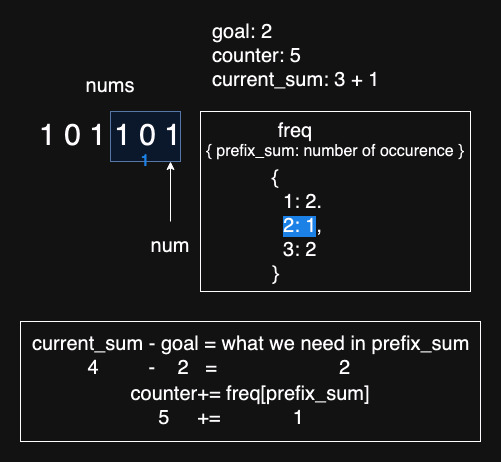930. Binary Subarrays With Sum

Overview
We need to determine how many sums of the subarrays can satisfy the goal.
This article will include the brute force approach using nested for loops
and using the prefix sum technique to resolve this question.
And the best solution should use the slide window technique.
However, after referring to the answer, I still haven't fully understood it.
Solution 1: Brute Force
Algorithm
Iterate through the nums array and countdown if the current sum is equal to the goal.
This solution will get Time Limit Exceeded.
Implement
class Solution: def numSubarraysWithSum(self, nums: list[int], goal: int) -> int: current_sum = 0 counter = 0 for i in range(len(nums)): current_sum = nums[i] if current_sum == goal: counter += 1 for j in range(i + 1, len(nums)): current_sum += nums[j] if current_sum == goal: counter += 1 return counter
Complexity Analysis
Time complexity: O(n^2)
Nested iteration through the nums array takes O(n^2).
Space complexity: O(1)
Solution 2: Prefix Sum
Algorithm
Iterate through the nums array.
- If the current sum equals to the goal, the counter should be increase by 1.
- If the current sum minus the goal equals the goal and has been recorded in the hash table,
the counter should be increased by the number of occurrence of the prefix sum.
This increase in the counter is due to
how many prefix sums can satisfy the goal, starting from the current iterate number. - Record the prefix sum and the number of occurrences.

This shows the situation in the last loop.
Implement
class Solution: def numSubarraysWithSum(self, nums: list[int], goal: int) -> int: counter = 0 current_sum = 0 # {prefix_sum: number of occurrence} freq = {} # To store the frequency of prefix sums for num in nums: current_sum += num if current_sum == goal: counter += 1 # Check if there is any prefix sum that can be subtracted # from the current sum to get the desired goal if current_sum - goal in freq: counter += freq[current_sum - goal] freq[current_sum] = freq.get(current_sum, 0) + 1 return counter
Complexity Analysis
Time complexity: O(n)
Iterate through the nums array takes O(n).
Space complexity: O(n)
Use an additional hash table to save the prefix sum and the number of occurrences.
In the worst-case scenario, the nums array consists entirely of 1s ([1, 1, 1, ... , 1]).
The hash table will take O(n) space, the same as the nums array.